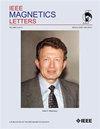具有多模超高速磁化开关的高密度1T1D1SOT-MRAM
IF 1.1
4区 物理与天体物理
Q4 ENGINEERING, ELECTRICAL & ELECTRONIC
引用次数: 0
摘要
在这封信中,我们提出了一种基于1T1D1M(一个晶体管、一个二极管和一个磁性隧道结)的自旋轨道转矩、具有多模磁化切换的磁性随机存取存储器(SOT-MRAM),用于高密度存储器、超高速写写和高能效片上存储器应用。传统的自旋转移力矩(STT)-MRAM或SOT-MRAM受到单极(或双极)开关特性的限制,并且需要利用具有双向写入电流的公共沟道,这不仅导致存取晶体管的源极退化,而且增加了写入操作中的能量消耗。通过引入肖特基二极管,基于多模式超快切换的1T1D1SOT-MRAM单元在不同方向的电流通道去耦和高密度集成方面优于传统MRAM。仿真结果表明,与STT-MRAM和SOT-MRAM相比,MRAM的位单元面积分别减少了82%和100%,并且与STT-MRAM相比,写入能耗提高了~3.3倍。本文章由计算机程序翻译,如有差异,请以英文原文为准。
High-Density 1T1D1SOT-MRAM With Multimode Ultrahigh-Speed Magnetization Switching
In this letter, we present a 1T1D1M-based (one transistor, one diode, and one magnetic tunnel junction) spin-orbit torque, magnetic random-access memory (SOT-MRAM) with multimode magnetization switching for high-density memory, ultrahigh-speed writing, and energy-efficient on-chip memory application. The conventional spin-transfer torque (STT)-MRAM or SOT-MRAM is limited by the unipolar (or bipolar) switching property and demands the utilization of a common channel with bidirectional write current, which not only brings about source degradation of the access transistor but also increases the energy consumption in the write operation. By introducing a Schottky diode, the 1T1D1SOT-MRAM cell based on ultrafast switching of multiple modes outperforms conventional MRAMs in terms of decoupling of current channels in different directions and high-density integration. Simulation results show that the MRAM achieves 82% and 100% reduction in bit-cell area compared with STT-MRAM and SOT-MRAM, respectively, and ∼3.3× improvement in write energy consumption in comparison with STT-MRAM.
求助全文
通过发布文献求助,成功后即可免费获取论文全文。
去求助
来源期刊

IEEE Magnetics Letters
PHYSICS, APPLIED-
CiteScore
2.40
自引率
0.00%
发文量
37
期刊介绍:
IEEE Magnetics Letters is a peer-reviewed, archival journal covering the physics and engineering of magnetism, magnetic materials, applied magnetics, design and application of magnetic devices, bio-magnetics, magneto-electronics, and spin electronics. IEEE Magnetics Letters publishes short, scholarly articles of substantial current interest.
IEEE Magnetics Letters is a hybrid Open Access (OA) journal. For a fee, authors have the option making their articles freely available to all, including non-subscribers. OA articles are identified as Open Access.
 求助内容:
求助内容: 应助结果提醒方式:
应助结果提醒方式:


